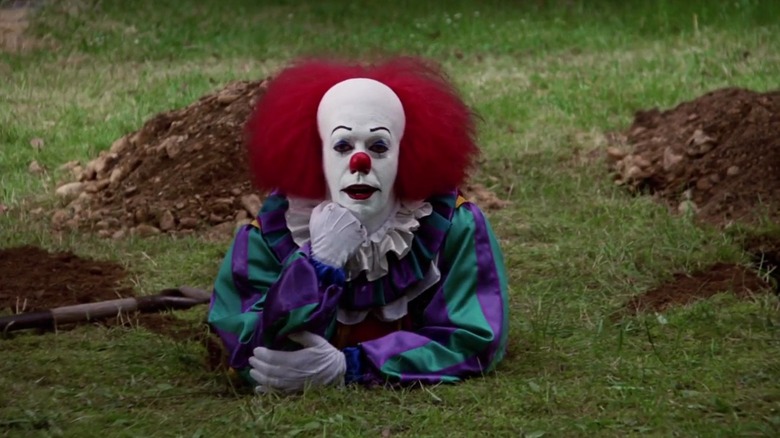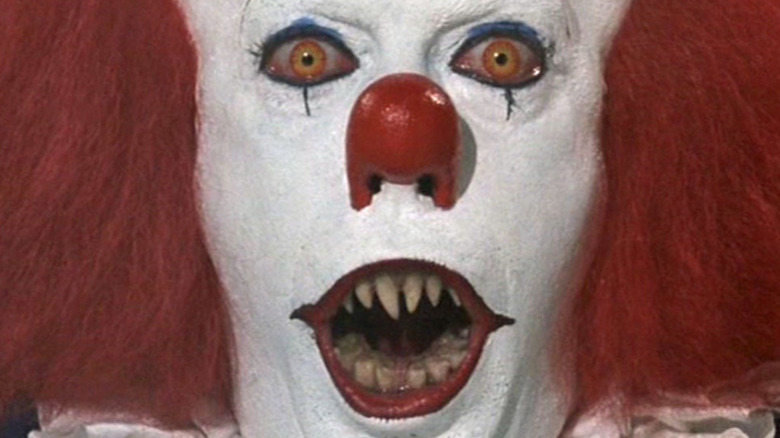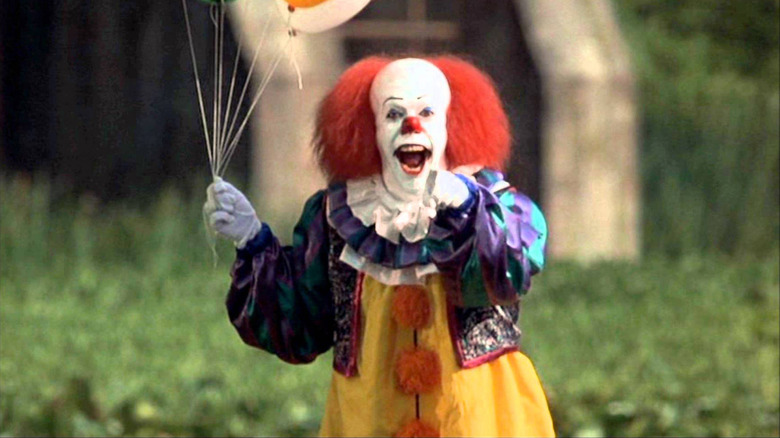Tim Curry's Pennywise Design Was Phantom Of The Opera By Way Of Hanna-Barbera
Stephen King's 1986 novel "It," for its overwhelming length and chronological sprawl, centers on a very simple and basic horror premise: clowns are terrifying. Perhaps there was a time in his planet's history when pale-faced, blue-haired ghouls with painted-on smiles and gin blossom encrusted noses were considered charming and delightful, but anyone who recalls that time died over a century ago. In 2022, many might readily agree that clumsy, "comedic" traditional circus buffoons are now merely greasy, manic, and threatening.
The monster in King's novel was an impossibly ancient shape-shifting Lovecraftian space deity that fed on human fear, with the ability to read human minds and manifest what they were most afraid of. Perhaps instinctually, the universal fear shape that this creature elected to take was that of a clown. It gave itself the name of Pennywise, and would hibernate in the sewers under Derry, ME, awakening every 27 years to frighten and eat children. "It" was adapted into a TV miniseries in 1990, and Pennywise was played by the inimitable Tim Curry.
Curry, being a versatile and energetic performer, brought a great deal of creepy, comedic bluster to the role, infusing Pennywise with an offbeat, flippant monstrousness that somehow made him more terrifying than any werewolf or vampire. In comparison to the ultra-artificial, Halloween mask, "Knotts Scary Farm" version of the character played by Bill Skarsgård in the 2017 and 2018 "It" feature films, Curry is far scarier. One looks like a fake monster designed in a Hollywood studio. The other one merely is a monster.
Of course, finding a good design for Pennywise took a great deal of thought and consideration. In a 2015 oral history of the "It" miniseries on Yahoo!, Bart Mixon, the special makeup effects supervisor, recalls the brainstorming and design process.
Drawing on Tim Curry's face
Mixon didn't start designing the Pennywise makeup until after Curry had already been cast. Using a copy the actor's photograph, he started penciling out a few ideas. This was followed by a standard practice of making a full plaster cast of the actor's head. Prosthetics-based makeup will require such casts for the artists to sculpt rubber and silicone pieces that will fit the actor precisely. When sculpting onto Curry's plastic head, Mixon thought of one famed movie monster in particular. He said:
"Once I got Tim's headshot, I did a tracing of and started making various design sketches. We also made a head cast and designed three clay sketches so we could see how the design would look in three dimensions. The basic inspiration was Lon Chaney's 'Phantom of the Opera,' stylized into a clown."
In Rupert Jillian's 1925 feature film "The Phantom of the Opera," based on the 1910 novel by Gaston Leroux, Lon Chaney played the title character, a sewer-dwelling organist whose face had been mutilated, and which he hid under a mask. Chaney created his own makeup for the role, stuffing wadding in his cheeks, adding black skeletal highlights around his eyes and lips, and inserting wires up into his nose. The result was something more ghastly than a typical death head. To this day, it remains one of the more striking makeup jobs in cinema history.
Seeing as how the Phantom was a sewer-dwelling monster, Mixon followed that Pennywise should evoke that. Notably, Chaney's upturned nose was incorporated.
The three Pennywises
Of course, there are several traditional clown templates from throughout clown history that one can draw from. Chaney even provided a notable clown design in Victor Seastrom's 1924 romantic tragedy "He Who Gets Slapped." Does one choose Chaney? Pagliacci? Joseph Grimaldi? Emmett Kelly? Bozo? John Wayne Gacy? Ronald McDonald? Mixon, it seems, fell back on a trio of templates. Apart from the design ultimately seen in the film, he chose a Kelly "hobo" clown, as well as a more directly mean-looking one. As he explains:
"We ended up doing three versions: one that was a little heavier, almost a hobo clown, one that was a little meaner, and the one you see in the show. Originally, we intended to have a prosthetic chin and cheekbones, but Tim wanted to wear as little prosthetics as possible. We did use a special kind of prosthetic make-up cream for the clown make-up, one that doesn't rub off. I wanted Pennywise to be very stylized, almost like a living cartoon."
One can see from the above photos that Pennywise is clearly not entirely human. The white prosthetic makeup made Curry's skin unnaturally smooth, almost like he was made of plastic or porcelain. His bald clown head is only slightly too large, giving Pennywise an alien appearance. And his clown nose seems to be disconcertingly part of his face. Oddly, the more traditional, conventional red and blue clown makeup somehow served to make Curry more terrifying.
If one could imagine a clown version of the Phantom of the Opera as drawn by Will Hanna and Joe Barbera, one can see how Pennywise would be the result.


